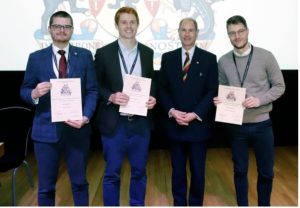 Dr Sam Humphry-Baker is an Imperial College Research Fellow in the Department of Materials. His research lies at the intersection of materials science and fusion engineering, where he develops new materials that can enable fusion energy reactors to be deployed on a smaller scale.
Dr Sam Humphry-Baker is an Imperial College Research Fellow in the Department of Materials. His research lies at the intersection of materials science and fusion engineering, where he develops new materials that can enable fusion energy reactors to be deployed on a smaller scale.
In this blog post, Dr Humphry-Baker shares more details about his research and passion for fusion energy.
Can you tell us more about your research area?
My research supports the development of fusion energy. In the past, fusion reactors have been very large and expensive to build, which has meant progress with the technology has been slow. However, recent developments of more powerful magnets have meant that the reactors can be made much smaller than previously.
The shrinking of the reactor leaves certain components more exposed to damage from high energy particles being produced by the fusion reaction. Usually, these components are protected by shielding, but current shielding materials are optimised for conventional nuclear power, so these components will begin to degrade within weeks or months. It is therefore important that new, more efficient shielding materials are developed.
My research seeks to design these materials so that the lifetime of the reactor can be extended to decades to enable commercial power production. My team and I at Imperial are designing new ceramic materials with orders of magnitude increases in reactor lifetime over conventional materials. This work is carried out in collaboration with leading fusion engineering companies like Tokamak Energy Ltd, as it is important to consider the issues involved with integrating these new materials into a real engineering system.
Once these materials have been designed on the computer, we must address the key scientific and engineering challenges governing their practical use. This is critical as these materials are not used industrially. Therefore, there is limited understanding of how they can be manufactured and how they will behave in the extreme conditions of a fusion reactor.
What are the main aims of your current research?
The first aim of my research relates to the manufacture of the materials. Because they are not widely available, we must develop a new understanding of how the fabrication variables can be optimised to gain optimal performance in the material. These ceramics melt at very high temperatures; therefore, we must build them up from powders. My team and I do this by fusing the powders together under heat and pressure, similar to how many high-temperature components like space shuttle tiles are made.
The second aim of my research is to demonstrate performance in reactor-like conditions. The key challenge is that they will be bombarded by high energy particles in the reactor. This is particularly damaging in a fusion reactor as the particle energy is much higher than in a conventional nuclear reactor. The bombardment tends to jumble up the arrangement of the atoms, which can make the materials more brittle; in the same way that when you bend a paperclip back and forth, it can eventually snap. To test this, we collaborate with experts in computer modelling to understand what kind of jumbling up processes are most important. Then we use specialist particle beam facilities to experimentally see what the jumbling up does to the structure of the material.
The final thrust of my research group is to engineer new composite structures with improved damage tolerance. One of the tricks we have used is to add a cement-like layer between relatively brittle ceramic particles. These kinds of structures are commonly found in nature; for example, sea-snail shells are built from thinly stacked layers of relatively brittle chalk-like ceramics, with a gluey substance in between. So, when predators strike the shell, cracks tend to stop in the glue, and the snail survives. Obviously, shells have had several million years of evolution to optimise their structure, whereas we must do it in a much shorter timescale, which is challenging but also exciting!
How could this research potentially benefit society?
My research in developing these materials could enable fusion reactors to be built at a much smaller scale than previously possible, meaning privately funded companies can now get involved for the first time. This accelerates the rate at which fusion energy can be rolled out in the future. For example, companies like Tokamak Energy and General Fusion plan to build energy demonstrating reactors in the 2020s. This is much earlier than the equivalent front running energy demonstrating fusion reactor being planned by international government collaboration, which is planned for 2050. Accelerating fusion’s development could allow us to help the UK in meeting its ambitious carbon emission targets.
Many of the environmental benefits of fusion are shared with renewable energy technologies like wind and solar. However, fusion has additional advantages in that there is no need for costly long-term storage for when it’s dark, or the wind isn’t blowing. Furthermore, since electricity only represents about a fifth of the UK’s energy usage, we must decarbonise our substantially larger needs from heating. Small fusion reactors could do this by heating our homes through district heating systems and powering challenging processes like steelmaking as they will operate at a much higher temperature than conventional nuclear reactors. A further advantage over conventional nuclear is that there is no risk of a reactor meltdown, and the waste produced is safe to handle and recycle after a much shorter time.
I recently attended the Earl of Wessex Future Energy Conference to explain my vision for how small fusion reactors can help the UK reach Net-Zero by 2050. My team and I were awarded a prize in the Young Persons energy pitch competition.

Dr Humphry-Baker and team picture with Prince Edward, Earl of Wessex.
What are the next steps in your research? Are there any challenges ahead?
We have already developed the maturity of our first generation of new shielding materials to a fairly high level. The next stage for these materials is to put them in a real nuclear reactor and study their performance in greater detail. These experiments are very costly and require collaboration with dedicated international facilities. We currently have materials sitting in a reactor at the Oak Ridge National Laboratory in the US, and we expect to start getting the first experimental results at some point later in the year, which is very exciting.
Once this work is complete, there are several engineering challenges that must be overcome before these materials can be deployed in a real fusion reactor. For example, we must develop new ways to join them to structural elements in the reactor and understand how they interact with coolants, which can often be corrosive.
Materials science is at the heart of many of these challenges, but solving them will require collaborating with a huge array of different engineers and scientists in the future. Interacting with these people keeps me fresh and energised to do this research!
